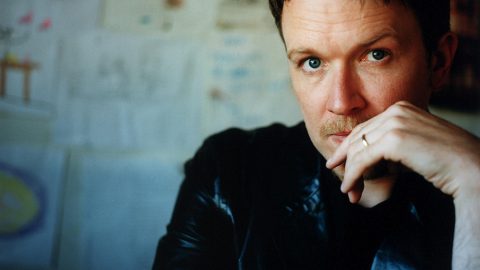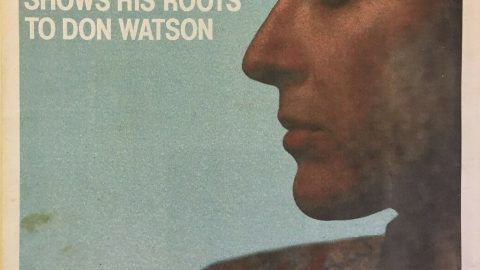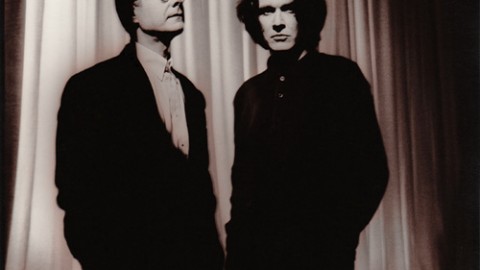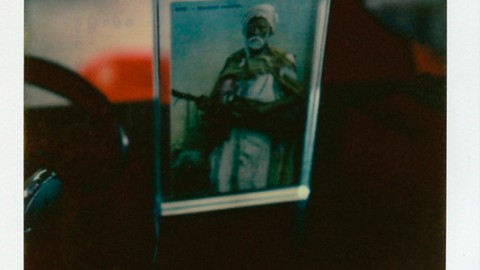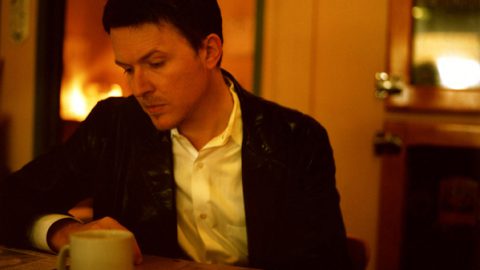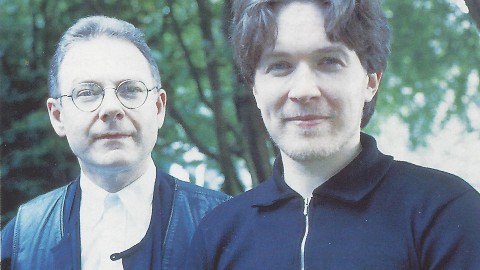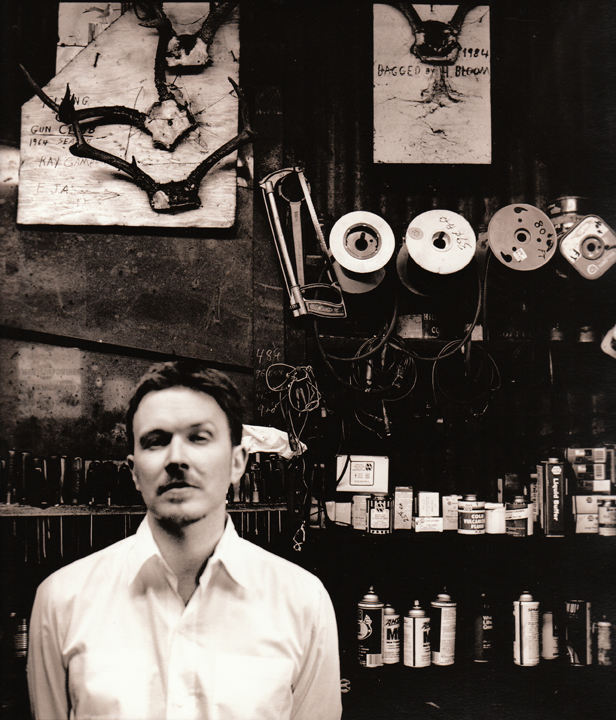
Wednesday, April 14, 1999 , Sylvian’s Bees buzzing again by DAVE VEITCH
Transcript by John Sakamoto. Originally online interview (now defunct)
Calgary Sun
Just three years ago, David Sylvian doubted he would — even could — make another solo record.
“There were times when I thought it was almost an impossible task and that I couldn’t see it being completed,” the musician said in a telephone interview yesterday.
Ultimately, the album was finished.
Dead Bees on a Cake, five years in the writing and three years in the recording, was finally released earlier this month.
It is only his fourth solo album since disbanding Japan in 1981, and it was his first solo effort since his 1987 masterpiece Secrets of the Beehive. The new record generally picks up where Beehive left off: The hushed, jazzy and ambient settings still dominate, though the influence of R&B seeps into songs such as I Surrender and Midnight Sun.
Lyrically, Dead Bees on a Cake acts as a travelogue for a journey of self-discovery that has, by all accounts, transformed the life of the critically adored singer-songwriter.
Coming out of a period of personal turmoil following Beehive, Sylvian married American musician Ingrid Chavez, a former Prince protege, with whom he’s had two children; moved from Britain to the U.S. (they now live in California’s Napa Valley); and followed the lessons of various “teachers, saints and holy people,” including a guru Shree Maa.
Over the phone, his genial, soft-spoken nature suggests Sylvian is a man at peace with himself.
The new album only supports that theory.
The album leads off I Surrender, on which Sylvian sings of opening “the pathway of the heart” and “sorrow collapsing into joy.”
“In a sense, that piece is like a mini-manifesto. It sets out the themes that are expanded upon the rest of the album,” Sylvian says.
“A lot of the themes running throughout the album have to do with a sense of travel, whether it be physical or internal journeys that are undertaken … although I certainly never planned it that way.”
Indeed, Dead Bees on a Cake was a difficult album to make. “Interminable,” is Sylvian’s description.
Dissatisfied with some performances, Sylvian now admits: “I didn’t select carefully enough the musicians I was bringing in.”
And problems with technology “slowed the project down months at a time.”
Even his working relationship with longtime musical soulmate Ryuichi Sakamoto — whose keyboard performances and string and horn arrangements are hallmarks on Sylvian’s solo albums — wasn’t as fruitful as usual. “That was crushing,” Sylvian says.
“It was just a matter of pushing on, keeping on with it…. It was drawn out over such a long period of time, but the wonderful thing was the material was strong enough that I could keep returning to it over and over again and still feel refreshed by it to some degree.”
Still, he enjoyed calling the shots (he produced and mixed and album himself, did most of the engineering and played many instruments) particularly after working in various collaborations throughout the ’90s — among them, an album with Robert Fripp (The First Day) and with his former Japan mates (under the moniker Rain Tree Crow).
“There is a great deal of compromise involved in collaborative work. It was wonderful to return to the solo material and see a project through,” he says.
Amazingly, Dead Bees on a Cake doesn’t sound like it was pieced together from a variety of different and difficult sessions.
Even at 70-plus minutes, it is as concise and coherent an album as Beehive and Sylvian’s equally accomplished solo debut, 1983’s Brilliant Trees.
The most surprising development, however, is the hint of R&B in several tracks.
He credits his wife for bringing his love of R&B to the fore in his own music.
“I was writing music for her to respond to and I knew (R&B) was an area of music that interested her and inspired her,” he says.
“Having completed a number of pieces with her, I started writing my own album and I had come across pieces I had written with Ingrid in mind that she didn’t have time to address. That’s how some pieces developed.”
——————————————————————————–
Thursday, 25 March, 1999
In conversation with David Sylvian
By JOHN SAKAMOTO
Executive Producer, JAM!
After several detours, false starts, and frustrating delays, David Sylvian’s first new solo album in 12 years, “Dead Bees On A Cake” is finally set to surface in Canada on April 6.
JAM! recently got a hold of a surprisingly open and engaging Sylvian on the line from his San Francisco-area home to talk about “Dead Bees”, as well as his early/mid-’90s collaboration with Robert Fripp, tour plans, and a wealth of unreleased material that will finally see the light of day on a compilation project he’s now working on.
Here is the full text of our conversation.
——————————————————————————–
JAM!: I have to admit when I first heard the title of the new album, I laughed out loud. I don’t know if you meant it to be humourous. I know the idea behind it relates to the concept of the self merging with the object of desire. Is that something that’s come out of the spiritual quest you’ve been on for the last few years?
D.S.: It is. And yes, the title was meant to be humourous. I’m glad you found it amusing. You’re the first person to have that response, as far as I’m aware. Yes, for sure it came out of the background to the teachings I’ve been involved in and obviously a notion that I’ve been aware of for many years; you know, having been taking quite a bit of interest in various spiritual disciplines over the years. It seems to have reached some kind of peak for me in terms of my own understanding of the concept and experience of it, so that is in some way reflected in the content of the album. I wanted to reflect it in the title, if in a somewhat oblique way, nevertheless I wanted it there.
JAM!: But this is a lesson you’ve had to learn, that you should not try to merge with the object of your desire?
D.S.: No, I still see it as a goal that’s perfectly desirable, I do.
JAM!: Even though the end result of the goal can be that you die?
D.S.: Well, the death of the ego. But then again, there are many deaths on the road to awakening, so the death of the ego is the ultimate; the death of the separates or the notion of the separate self or the awareness of the separate self. So that these become part and parcel of the cake. They merge with it, they die into it.
JAM!: Is there any sort of direct link with “Secrets Of The Beehive”, or is that just a coincidence?
D.S.: You could draw certain lines that would link one to the other but I’ve never considered them linked in that respect. It’s more of a coincidence. I was very reluctant to return to the bee imagery or the metaphor but there it was. I was living with that title for some time. It just appealed to me, it became the title of the album. I had no choice.
JAM!: The music on “Dead Bees On A Cake” struck me as sounding very ‘lived in’. It didn’t sound as though someone had gone into the recording studio for ‘x’ number of months and recorded 14 songs. It sounded as though it was almost sort of a herky jerky process, I suppose, and maybe that has more to do with the lyrics and the vocals than it does with the production or the sound of the music. Was this a very interrupted process for you?
D.S.: It was. The writing was uninterrupted and was taken care of pretty quickly but the recording process was very drawn out.
JAM!: Deliberately so?
D.S.: No. I started out working with Ryuichi Sakamoto in New York and we did three weeks work together. Initially Ryuichi was co-producing the project with me, and after three weeks work we had about three days work down and it was obvious things weren’t working as well as they usually are between the two of us. So we decided to call it quits. I captured some wonderful moments from the sessions in the string arrangements, the brass and some piano work of Ryuichi’s but we were way behind where I’d expected to be at that point.
I did a few other sessions in New York the strongest being the work with Eno, which was like an afternoon’s work but an awful lot was given to me in that afternoon to work with. I then set up a second set of sessions in the real world in England and the same thing happened to me. I had a series of musicians, and the material wouldn’t take shape. The musicians couldn’t find their way in the work and it was completely surprising to me because this has never happened to me before and I didn’t think the material was that difficult, so it was baffling. But there I was going through drummer after drummer, bass guitarists, percussionists and really coming away with very, very little.
So I returned to Minneapolis where I was then living and just basically started sampling the material that I had and reconstructing the arrangements to try and put together a basis from which to get working on the album. You know, three months (and) there was very little to show for it. That was the beginning, and it kind of went on like that and I found myself just taking on roles that I hadn’t really initially foreseen myself taking on: being the sole producer, taking care of engineering, becoming the maintenance guy, your own studio, you know anything that just gets down to the basic work of being creative and recording.
JAM!: So did you end up having to painstakingly reconstruct or piece together songs for a variety of performances, or did you actually go back and re-record with another set of musicians?
D.S.: I reconstructed the pieces through using various samples from a multitude of performances. The challenge really was to keep the whole thing feeling very organic, like there was a group of people playing together, that sonically it sounded very much a part of a whole, which was quite a challenge actually. Probably a greater challenge than actually putting the arrangements together.
JAM!: Was part of the problem that the musicians couldn’t sort of lay back and sound like one unit?
D.S.: In part maybe. I don’t really want to get into what wasn’t suitable. I just felt the performances weren’t … I’ll give you one example. I was working with Bill Frisell in Seattle. I obviously think Bill is an amazing guitarist. We did two days work together and he contributed a lot of work to many of the pieces. But when I got the work back home and started listening through to it, although the performances were beautiful, they didn’t draw out of the pieces the emotional response that I was looking for. So I had to go back and actually replace many guitar parts with my own guitar playing, which is technically inferior, obviously, to Bill’s playing.
I was able to bring to the work the emotional content that I was trying to draw forth out of the composition. So I had to replace some technically proficient and beautiful work with something that was less proficient but remained truer to the piece of the music. That’s something I’ve never really had to do much of in the past; I could rely on a key person’s performance to be totally in sync with the piece of music that I was working on. Maybe as I’ve matured I’m looking for something far more specific and therefore I was being more demanding of the people that I was working with and when I didn’t find it, it meant that I had to go back and find the resources within myself to put that on to disc.
JAM!: Is it possible that the work is so personal that the only person who’d be able to elicit the emotional response you were after is yourself?
D.S.: I think that’s very much a big part of it, yeah.
JAM!: How much of an adjustment was it going back to working not solo, in the sense of you playing everything, but without an equal collaborator?
D.S.: It was an enormous relief, to be honest. You know the collaborative workouts are amazing on a whole series of levels. Regardless of the end result, you tend to learn a great deal in the process of working with these people. There were rewards but, ultimately, you find yourself unable to stand completely 100% by the work and say you know, “Yes, I stand by this work, this represents this or that aspect”.
There are so many compromises made along the way that I tend to find that I’m not 100% with the work. After a period of time it began to wear on me that I wasn’t putting out work that I felt really strongly about. I guess I was getting to a point in time, a state of mind, where there were issues that I wanted to confront in my writing that I felt uncomfortable doing in the context of a collaboration. So, it felt time to return to the solo work. Prior to even the Sylvian/Fripp collaboration I was sort of focusing, beginning to focus on writing again and was really ready to get back by the time the Sylvian/Fripp project came to an end.
JAM!: Were there other things happening in your normal life while the recording process was going on to sort of interrupt the sessions, along with the problems you’d had in the studios?
D.S.: Sure, yeah, there was a whole lot going on, in that life just became so interesting and it would just draw me away from the work for months at a time. The work would be shelved for very long periods at certain points in time. My family, having two daughters and again finding the teachers that we did and traveling with the teachers and having a multitude of experiences in their company, so these things were major events in my life, key events and in some way they are documented in the album itself.
The album was borne out of that environment where all these things were taking place, so it became part and parcel of this overall experience. I can’t separate the writing/recording of the album from all that was going on then, and it really was the richest, most eventful period of my life to date. You know, there was a lot happening. Obviously I was learning a great deal just being with the family, being a very much close-knit family living in Minneapolis as we were. You know you have these very long winters, you lead almost a hermetically sealed existence because you don’t go out very often and when you do it’s just from A to B and back again, so you tend to live out of one another’s pockets. Which was a great experience; the first five years of my first daughter’s life, we were very much at home there with her and bringing her up, so that was amazing to have that time to commit to that relationship.
And as I said again, the teachers; that was a whole other thing which brought a great richness into our lives, as well as periods of self-doubt and self-analysis which we made some discoveries about ourselves, (and) they’re not always easy discoveries to make. It means that you have to go through a process of really facing these problems and working through them. Ultimately, it’s greatly rewarding but at the time they can seem just so monstrously difficult to work through.
JAM!: Was the sort of hermetically sealed existence in Minneapolis, was that one of the reasons you decided to pick up and move to San Francisco?
D.S.: No. There are two reasons for that. Ingrid (Chavez, Sylvian’s wife) was ready to move on because she had been living in Minneapolis for, I don’t know, 12 years, by the time we picked up. The main reason was that this Indian holy woman Shremar came to stay with us for a period of time, and the experience of living with her for four or five days was so intense that we picked up and moved to a place to where she was living in the Napa Hills so that we could be close to her for a period of time. And when we felt that we had taken enough from that experience, we kind of picked up and moved on again, so we’re down in the Valley. But that’s really what drew us out here initially.
JAM!: Originally I was thinking of asking what the influences have been of you living in the U.S. for the past four or five years, but I couldn’t really detect any hint of the influence of the outside world in general. The album sounds very intimate, as though it was recorded in a small, dark space. It certainly doesn’t sound as though it’s the work of someone who has picked up and moved from one place to another.
D.S.: Well, the bulk of the work was done in Minneapolis. When we did pick up and move, all I had left to do was just some finishing off a few of the pieces in terms of guitar and keyboard overdubs, but mainly all the vocals were recorded here in California. And that was a luxury because I was alone and could work entirely alone recording the vocals, which is a new experience for me. It contributed to that sense of intimacy that I think is quite palpable on the album.
JAM!: Whose voice is that on “Cafe Europa”?
D.S.: That’s my wife’s voice.
JAM!: I guess in a way you ended up sampling your own work, in that in some instances you were trying to piece together songs from different performances. Did you use any (outside) samples on the album?
D.S.: Oh yeah. The opening track, “I Surrender”, takes its cue from a sample from the Mahavishnu Orchestra. John Lee Hooker is sampled on “Midnight Sun”. John Cage on “Pollen Path”. There are a few floating around in there.
JAM!: What is the Mahavishnu track that you used on “I Surrender”?
D.S.: Oh my goodness, no, I don’t remember.
JAM!: How about the John Lee Hooker?
D.S.: John Lee Hooker’s is a track called “I’m Wondering”.
JAM!: The tracks “God Man” and “Pollen Path” seem ripe for some radical remixes. Have you thought about allowing any of the tracks to be reinterpreted by somebody else?
D.S.: Yeah, “God Man”. I felt that about “God Man” also. There’s so much going on in there I thought, you know, somebody could draw a completely different conclusion when remixing the track. So, yeah I would like to do that. One person, I believe, is already in the process of having a bash at it. I believe we’re going to hand it out to a couple of different people to see what the response is.
JAM!: Did you record a lot of material during the sessions for “Dead Bees On A Cake” that didn’t make the final cut, because I noticed there are a bunch of B-sides listed for the European releases of the first single. (NOTE: The B-sides are “Les Fleurs Du Mal”, “Starred And Dreaming”, “Whose Trip Is This?” and “Remembering Julia”.)
D.S.: No the pieces on the B-side of the first single are from sessions that Ingrid and I did together at home, prior to my starting work on this album. So they’re kind of pieces in demo form really but, as we were never going to pursue them … I mean, if we get back into the studio together we’ll start writing new material because this new material is rather, perhaps it’s ‘sell-by date’ has passed for us. We worked on it many years ago, maybe five years ago, and it was just actually prior to our first daughter being born. So we were writing and recording this material right up until the night she was born, in fact, and then it kind of got shelved because we got totally immersed in that experience. So I really wanted to put it out there because I think it shows, it kind of mapped out the possibilities for the future.
JAM!: So you weren’t necessarily working on a project together?
D.S.: No, we were just writing together to see what the possibilities were, you know, just that the possibilities seemed wide open. So it’s like, ‘What should we do?’ We just mapped out some ideas to see where it led us and what would get us excited. So that material on the B-side of the single is fairly diverse, but you know, they’re quite different from one another and there were more pieces that we got involved in. So, you know that’s the one collaboration that’s continuing. We really wanted to continue working together, and it just seems that there are enormous possibilities there in that musical relationship. So that will be pursued. To answer the question, there were other pieces recorded, yes, in these sessions that didn’t make it onto the final cut. I’m sure they’ll see the light of day at some point.
JAM!: Is there a real Julia in “Remembering Julia”?
D.S.: Julia is a reference to Ingrid herself.
JAM!: Are you going to shoot a video for “I Surrender”?
D.S.: I would very much like to. It’s a matter of persuading Virgin to go ahead with it.
JAM!: And I guess there’s the inevitable tour question. It’s interesting to try to imagine how you’ll perform this material on stage.
D.S.: I would very much like to tour but it won’t be in the short-term. I guess either later in the year or maybe this time next year, it could even be as late as that. But I would very much like to tour the material, it’s just that I’ve concerns right now that prevent me from doing so.
JAM!: The song title “Thalhiem” (from Dead Bees On A Cake) — what does that word mean?
D.S.: It means ‘little village’, actually. It’s a place in Germany. It’s a place where another holy Indian woman resides, her name is Mother Mira. The song kind of documents my experience with that teacher, but it also documents my experience with my wife so I can’t actually differentiate between the two in the track. They just kind of merged into one because I experienced them with Ingrid and I experienced Mother Mira with Ingrid. I guess I’ve tried throughout the album not to be too dogmatic about what it is that draws me to certain conclusions and draws me to write about these experiences. As I’ve always done, I’ve tried to leave the pieces quite open to interpretation. Some of the pieces are directly about my own relationships with certain teachers and can be interpreted as a one-on-one relationship, or a personal relationship so that it enables other people to connect with the work.
JAM!: Between working with Robert Fripp and finishing “Dead Bees On A Cake”, did you guest on anyone else’s music that we might not have gotten to hear over here?
D.S.: Ummm, it’s hard for me to keep track of the sequence of events. I contributed to a couple of Italian recordings (“Marco Polo I & II”) and I contributed to Russell Mills’ album. That came out on a small British label called Time, which has since gone bankrupt. Which is a shame because it released some very interesting recordings in its short lifespan, Russell’s being one of them. I think that was all though. I don’t think I contributed to anything else. (Note: Sylvian also appeared on “Ti Ho Aspettato” (“I Have Waited For You”) on L’Albero Pazzo by Andrea Chimenti. Thanks to Sylvian fan Gerrit Hillebrand of Trophies: The David Sylvian Rarities Archive, for this information.)
JAM!: For someone who hasn’t been especially prolific in terms of album, album, album, you have a fairly extensive discography, if we start documenting all the things you’ve done. Do you have any other plans for any other work outside of the album and talking about the album for the next little while?
D.S.: Yeah, I’m working on some new material that has just been sent to me by an L.A.-based artist. I won’t mention his name because we haven’t ironed out all the details, so it may not happen. I may work on Russell Mills’ latest project. Russell has an interesting approach to making albums because he’s really not a musician himself, but he KNOWS a lot of musicians. So he kind of just calls up and says, ‘Send me some samples’. So all these really wonderful musicians from around the world send him these samples and he puts the pieces together in the studio with a couple of other talented musicians and comes up with this rather interesting, eclectic album. So I may contribute to that. Other than that I’m working on a compilation album for Virgin, which they’ve been bugging me for for years now. I’m looking forward to getting to grips with that at this moment in time, prior to getting on with new material.
JAM!: A compilation of just your solo work or all of the collaborative work?
D.S.: Solo and collaborative work.
JAM!: So, post-Japan then?
D.S.: Post-Japan. Just trying to draw together all the loose ends, you know so you get an overall picture of what’s been done, which would include some of the collaborative work that is relatively scarce, you know something that’s hard to come by, as well as the solo work and the more popular collaborations that I’ve been involved in.
JAM!: Will there be any unreleased material?
D.S.: Yeah, for sure.
JAM!: Is it sort of a big fancy box, that kind of project?
D.S.: I hope not, no. I’m kind of tired of those. I started out doing these box sets, with beautiful packaging and now I’ve had them hoisted upon me so often, you know Virgin seems to think ‘well, if Sylvian releases an album we’d better package it up really nicely’. Can’t we just put it out as a regular CD for heaven’s sake? So, no I hope it’s just like a regular release, just an overview to date.
JAM!: So this is something that might come out later in the year?
D.S.: It will probably come out this time next year, which would probably coincide with the tour if that is indeed when it’s to take off. That would be great actually to time it with the release of the compilation.
JAM!: You don’t sound all that enthusiastic about the task.
D.S.: Of touring?
JAM!: No, of putting together this compilation.
D.S.: (Laughs). No, actually there are aspects of it I really am looking forward to. I am going to re-perform a number of the pieces from the past. Then there were some really strong pieces that just don’t make it on to the final albums due to budget restrictions or whatever other problems, obstacles that I’ve come across over the years. So there’s some really beautiful material that’s just never seen the light of day, and I hope to incorporate a number of those pieces on the album. So there IS reason for me to feel enthusiastic about completing the project.
JAM!: Can you talk a little bit about some of that material? Are there specific pieces with titles and so forth that are recorded that just got dropped off at the last minute?
D.S.: There’s a piece called “Ride” from the “Beehive” sessions, which was actually the centrepiece of the album. I mean it kind of made sense of the whole for me. It just never got completed due to budget restrictions, you know I ran out of money, Virgin weren’t willing to put more into it so the album had to be wrapped up as it was. So there’s actually two tracks from that series of sessions, “Riot” being by far the most important track. There’s an original version of “Damage” that Robert and I recorded together which has never seen the light of day, which is also very beautiful. In some cases the pieces, the tracks are finished and other cases all it needs is like a vocal to be performed and it will be ready to go. There are some nice things out there that just sit in Virgin’s vaults, you know waiting to be discovered. So I really would like to draw those out.
JAM!: What was the other “Beehive” track that didn’t make it?
D.S.: There’s a piece called “Promise”. (Note: The track, subtitled “The Cult Of Eurydice”, is included on a just-released Japanese reissue.) That one is actually completed now, it’s actually finished, so it just depends how much I can squeeze on to the album. There are other pieces. There’s one piece that I recorded with a couple of Italian artists (Nicola Alesini and Pier Luigi Andreoni), a piece called “The Golden Way”. which I think is a beautiful piece which I would love to get my hands on and remix and put that on the album. So there’s all these disparate compositions lying around here and there that I would like to draw together and pull together for this album. But it would help create a more complete overview of what I’ve been up to since the band (Japan) split.
JAM!: Are you tempted to go back to “Beehive” and include at least the one track that didn’t get included the first time?
D.S.: You know, I would love to do that. I mean if I got all this material wrapped up, at some point in the future I would love to re-release the album in the form that I’d intended.
JAM!: That would be fascinating for those of us who’ve become so familiar with it but didn’t realize that the “centrepiece” wasn’t there. Well, thank you very much for your time, David, and hopefully we’ll get a chance to see you in this part of the world some time in the not too distant future.
D.S.: It’s been a pleasure talking to you, John.

